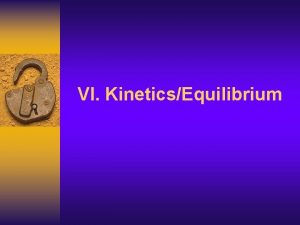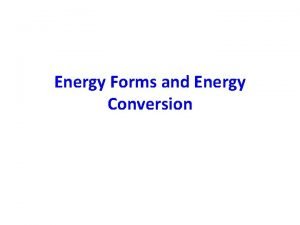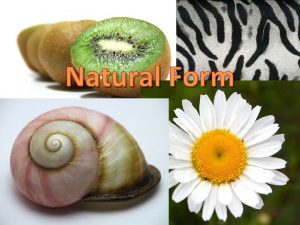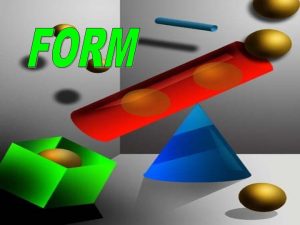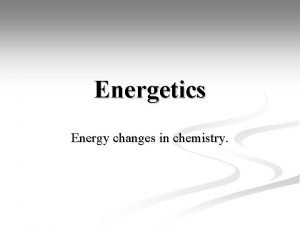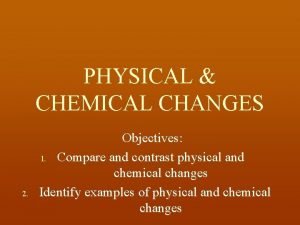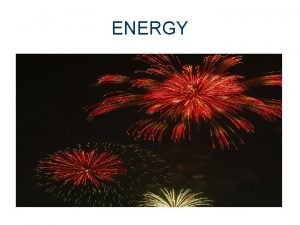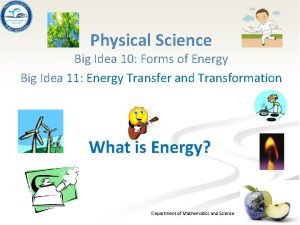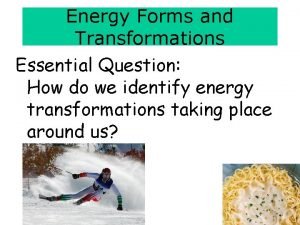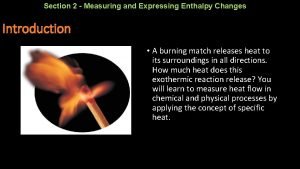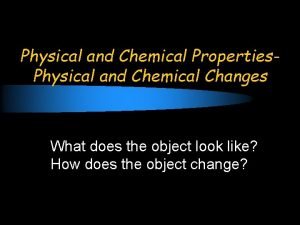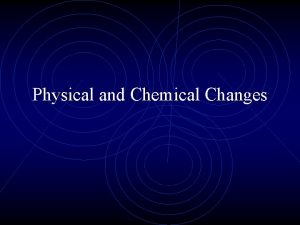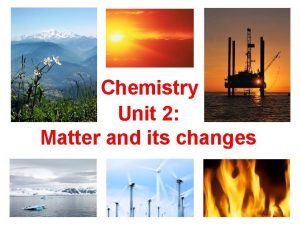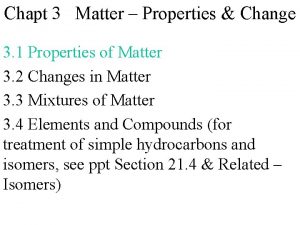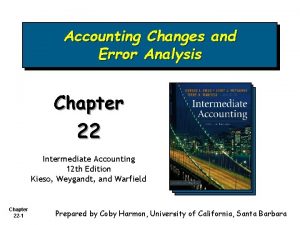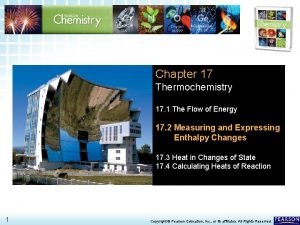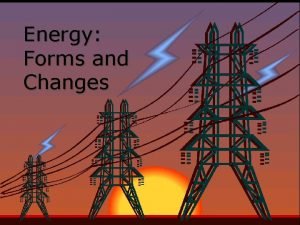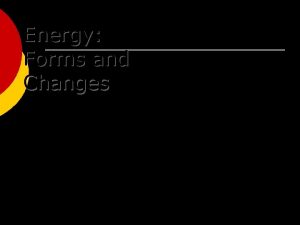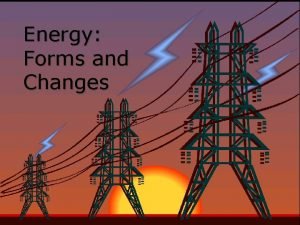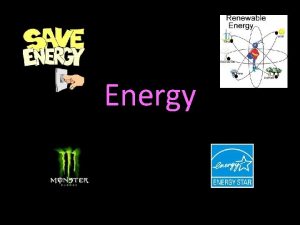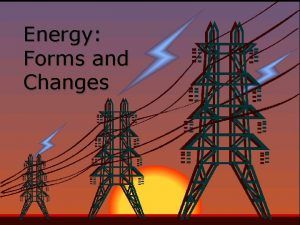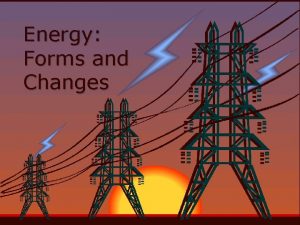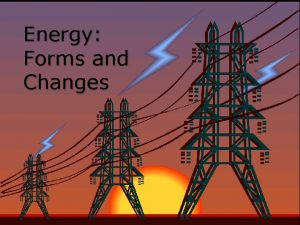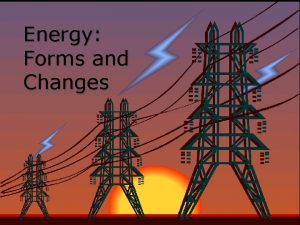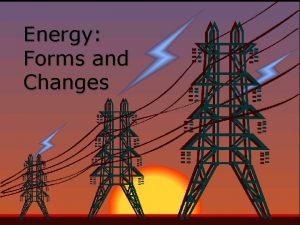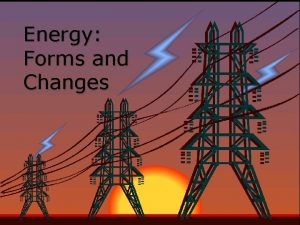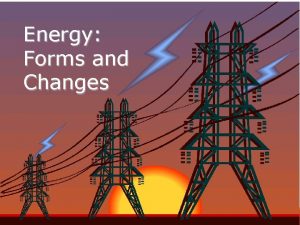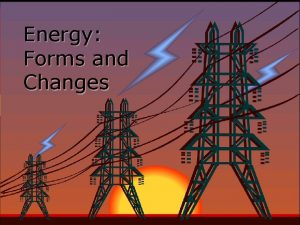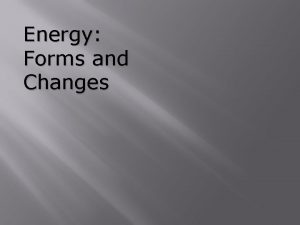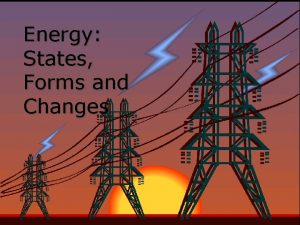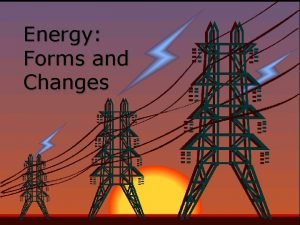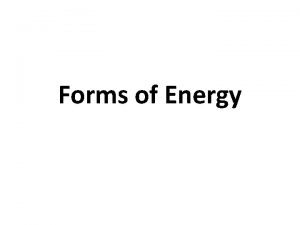Energy Forms and Changes Nature of Energy Energy









































- Slides: 41

Energy: Forms and Changes

Nature of Energy ¡ Energy is all around you! You can hear energy as sound. l You can see energy as light. l And you can feel it as wind. l

Nature of Energy ¡ You use energy when you: l l l hit a softball. lift your book bag. compress a spring.

Nature of Energy ¡ Energy is involved when: l l a bird flies. a bomb explodes. rain falls from the sky. electricity flows in a wire.

Nature of Energy ¡ What is energy that it can be involved in so many different activities? l Energy can be defined as the ability to do work. l If an object or organism does work (exerts a force over a distance to move an object) the object or organism uses energy.

Nature of Energy ¡ Because of the direct connection between energy and work, energy is measured in the same unit as work: joules (J). ¡ In addition to using energy to do work, objects gain energy because work is being done on them.

Forms of Energy ¡ The seven main forms of energy are: Heat l Chemical l Electromagnetic l Nuclear l Mechanical l Electrical l Sound l

Sound Energy The energy that creates a vibration or disturbance of matter.

Heat (Thermal) Energy The internal motion of the atoms is called heat energy, because moving particles produce heat. ¡ Heat energy can be produced by friction. ¡ Heat energy causes changes in temperature and phase of any form of matter. ¡

Chemical Energy ¡ Chemical Energy is required to bond atoms together. ¡ And when bonds are broken, energy is released.

Chemical Energy ¡ Fuel and food are forms of stored chemical energy.

Electrical Energy ¡ Power lines carry electrical energy into your home in the form of electricity.

Electromagnetic (Radiant) Energy ¡ ¡ ¡ Light is a form of electromagnetic energy. Each color of light (Roy G Biv) represents a different amount of electromagnetic energy. Electromagnetic Energy is also carried by X-rays, radio waves, and laser light.

Nuclear Energy ¡ The nucleus of an atom is the source of nuclear energy.

Nuclear Energy When the nucleus splits (fission), nuclear energy is released in the form of heat energy and light energy. ¡ Nuclear energy is also released when nuclei collide at high speeds and join (fuse). ¡

Nuclear Energy ¡ Nuclear energy is the most concentrated form of energy. The closest nuclear power plant to us is Plant Farley outside of Dothan, Alabama.

Where do we get our power


Mechanical Energy ¡ When work is done to an object, it acquires energy. The energy it acquires is known as mechanical energy.

Group Activity: You are building a village, and you have several tasks ahead of you! You group task is to decide what kind of power supply your village will have to use. You must research all types of power facilities and decide which on will be best for your village. Your choices: coal-fired, natural gas, nuclear, hydrological, combined turbine

ENERGY TRANSFORMATIONS A. B. Energy is constantly _________ from one form to another. The sum of the ____________ and _________energy is called the ______________ energy (ME). 1. ME= _____ + ______

Energy Conversion ¡ Energy can be changed from one form to another. Changes in the form of energy are called energy conversions.

Energy conversions ¡ All forms of energy can be converted into other forms. l l The sun’s energy through solar cells can be converted directly into electricity. Green plants convert the sun’s energy (electromagnetic) into starches and sugars (chemical energy).

Chemical Heat Mechanical

States of Energy The most common energy conversion is the conversion between potential and kinetic energy. ¡ All forms of energy can be in either of two states: ¡ l l Potential Kinetic

States of Energy: Kinetic and Potential Energy ¡Kinetic Energy is the energy of motion. ¡Potential Energy is stored energy.


Kinetic Energy The faster an object moves, the more kinetic energy it has. (velocity) ¡ The greater the mass of a moving object, the more kinetic energy it has. ¡ K. E. = 1/2 mv 2 What has a greater affect of kinetic energy, mass or velocity? Why?

Potential Energy ¡ Potential Energy is stored energy. l Stored because of the work done on it: ¡ Stretching a rubber band. ¡ Winding a watch. ¡ Pulling back on a bow’s arrow. ¡ Lifting a brick high in the air.

Potential Energy stored in an object due to its position is potential energy (PE). a. b. The higher the object off the ground the greater the position and the larger the potential energy. The formula for potential energy is PE=mgh. g=9. 8 m/s 2 on Earth

Gravitational Potential Energy ¡ Potential energy that is dependent on height is called gravitational potential energy.

Potential Energy ¡ Energy that is stored due to being stretched or compressed is called elastic potential energy.

Energy Problems Example 1: What is the Kinetic Energy of a 1000 kg car moving at 30 m/s?

Energy Problems Example 2: What is the mass of a car moving of 10 m/s if its kinetic energy is 40, 000 J?

Energy Problems Example 3 : How fast is a 45 kg girl running if her kinetic energy is 51 J?

Energy Problems Example 4: A 0. 06 kg tennis ball is 2. 9 m above the ground. How much potential energy does the ball have?

Energy Problems Example 5: How high would a 55 kg boy need to be to have 700 J of potential energy?

The Law of Conservation of Energy ¡ Energy can be neither created nor destroyed by ordinary means. l l It can only be converted from one form to another. If energy seems to disappear, then scientists look for it – leading to many important discoveries.


Kinetic vs. Potential Energy At the point of maximum potential energy, the car has minimum kinetic energy.

Vocabulary Words energy mechanical energy thermal energy solar energy chemical energy electromagnetic energy nuclear energy kinetic energy potential energy gravitational potential energy conversion Law of Conservation of Energy
 Elizabeth mulroney
Elizabeth mulroney What are the chemical change
What are the chemical change Collision theory states that
Collision theory states that Nature and nature's law lay hid in night
Nature and nature's law lay hid in night Affirmative short form
Affirmative short form Weak and strong form of can
Weak and strong form of can Energy forms and energy conversions
Energy forms and energy conversions Nature nature controversy
Nature nature controversy Naturalfarms
Naturalfarms Why are related forms more agreeable than unrelated forms?
Why are related forms more agreeable than unrelated forms? Why are related forms more agreeable than unrelated forms
Why are related forms more agreeable than unrelated forms Why are related forms more agreeable than unrelated forms?
Why are related forms more agreeable than unrelated forms? Enthalpy of reaction examples
Enthalpy of reaction examples Energy changing forms
Energy changing forms Energy changes
Energy changes What is thermochemistry
What is thermochemistry Compare and contrast physical and chemical changes
Compare and contrast physical and chemical changes Marriages and families changes choices and constraints
Marriages and families changes choices and constraints Marriages and families changes choices and constraints
Marriages and families changes choices and constraints 6 main forms of energy
6 main forms of energy Which is a “big idea” of physical science?
Which is a “big idea” of physical science? 100 examples of energy transformation
100 examples of energy transformation Energy energy transfer and general energy analysis
Energy energy transfer and general energy analysis Energy energy transfer and general energy analysis
Energy energy transfer and general energy analysis Measuring and expressing enthalpy changes
Measuring and expressing enthalpy changes Properties and changes of matter worksheet
Properties and changes of matter worksheet Physical and chemical changes
Physical and chemical changes Physical and chemical changes
Physical and chemical changes Is sawing wood a chemical change
Is sawing wood a chemical change Physical and chemical changes generation genius
Physical and chemical changes generation genius Wadding up paper
Wadding up paper Chemical change and physical change
Chemical change and physical change Difference between chemical and physical changes
Difference between chemical and physical changes Definition of substance
Definition of substance Matter-properties and changes answer key
Matter-properties and changes answer key Chapter 22 accounting changes and error analysis solutions
Chapter 22 accounting changes and error analysis solutions 17.2 measuring and expressing enthalpy changes answers
17.2 measuring and expressing enthalpy changes answers Lesson 3 physical and chemical changes answers
Lesson 3 physical and chemical changes answers Planning for choices and changes
Planning for choices and changes Whats the difference between a physical and chemical change
Whats the difference between a physical and chemical change Physical and chemical changes jeopardy
Physical and chemical changes jeopardy Which is an example of a physical change
Which is an example of a physical change


